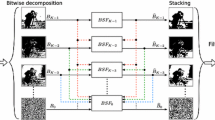Abstract
In this paper the use of oriented zero crossings of bandpassed images as representational primitives for hierarchical operations is discussed. Some theoretical properties of oriented zero crossings are presented and a hardware system for the production of a zero-crossing “pyramid” is proposed. The hardware processor utilizes a set of “systolic” array processors which implement two-dimensional digital lowpass and bandpass filters as well as zero-crossing detectors and zero-crossing orientation measurements. A multilevel interleaved system is described which allows concurrent processing of two sets of image descriptions and ensures that the component processing elements are utilized to the fullest. Results provided by simulations of the system applied to real imagery are described.
Access this chapter
Tax calculation will be finalised at checkout
Purchases are for personal use only
Preview
Unable to display preview. Download preview PDF.
Similar content being viewed by others
References
S. L. Tanimoto: “Regular hierarchical image and processing structures in machine vision”, in Computer Vision Systems, ed. by A. R. Hanson, E. M. Riseman (Academic Press, New York, 1978), pp. 165–174
F. W. Campbell, G. F. Cooper, C. Enroth-Cugell: The spatial selectivity of the visual cells of the cat, J. Physiology (London) 203, 223–236 (1969)
C. Blakemore, F. W. Campbell: On the existence of neurons in the human visual system selectively sensitive to the orientation and size of retinal images, J. Physiology (London) 203, 237–260 (1969)
D. Marr, T. Poggio: A computational theory of human stereo vision, Proc. Royal Society (London) B204, 301–328 (1979)
D. Marr, S. Ullman: Directional selectivity and its use in early visual processing, Proc. Royal Society (London) B211, 151–180 (1981)
M. D. Kelly: “Edge detection in pictures by computer using planning” in Machine Intelligence 6, ed. by B. Meitzer, D. Michie (Edinburgh University Press, Edinburgh, UK, 1971), pp. 379–409
R. Nevatia: Depth measurement by motion stereo, Computer Graphics Image Processing 5, 203–214 (1976)
W. E. L. Crimson: A computer implementation of a theory of human stereo vision. Philosophical TranSo Royal Society (London) 8292, 217–253 (1981)
H. H. Baker, T. O. Binford: “Depth from edge and intensity based stereo,” in Proc. 7th Intl. Joint Conf. Artificial Intelligence, Vancouver, BC, 1981, pp. 631–636
S. Ullman: Analysis of visual motion by biological and computer systems, Computer 14 (8), 57–69 (1981)
B. F. Logan: Information in the zero crossings of bandpass signals, Bell System Technical J. 487–510 (1977)
D. Marr, S. Ullman, T. Poggio: Bandpass channels, zero crossings, and early visual information processing, J. Optical Society America §1, 914–916 (1979)
D. Marr, E. Hildreth: Theory of edge detection, Proc. Royal Society (London) B207, 187–217 (1980)
J. Clark: Ph.D. dissertation, University of British Columbia, in preparation
M. S. Longuet-Higgins: The distribution of intervals between zeros of a stationary random function. Philosophical Trans. Royal Society (London) A254, 557–599 (1962)
J. H. McClellan: “The design of two-dimensional digital filters by transformations”, in Proc. 7th Princeton Conf. on Information Sciences and Systems (1973)
J. H. McClellan, T. W. Parks, L. R. Rabiner: A complete program for designing optimum FIR linear phase digital filters, IEEE Trans. Audio Electroacoustics AU-21, 506–526 (1973)
H. T. Kung: Why systolic architectures?. Computer 15(1), 37–46 (1982)
Author information
Authors and Affiliations
Editor information
Editors and Affiliations
Rights and permissions
Copyright information
© 1984 Springer-Verlag Berlin Heidelberg
About this chapter
Cite this chapter
Clark, J.J., Lawrence, P.D. (1984). A Hierarchical Image Analysis System Based Upon Oriented Zero Crossings of Bandpassed Images. In: Rosenfeld, A. (eds) Multiresolution Image Processing and Analysis. Springer Series in Information Sciences, vol 12. Springer, Berlin, Heidelberg. https://doi.org/10.1007/978-3-642-51590-3_11
Download citation
DOI: https://doi.org/10.1007/978-3-642-51590-3_11
Publisher Name: Springer, Berlin, Heidelberg
Print ISBN: 978-3-642-51592-7
Online ISBN: 978-3-642-51590-3
eBook Packages: Springer Book Archive




